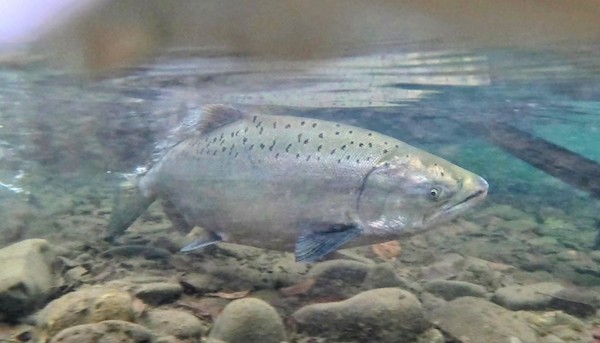
NMFS: OR Coast Chinook Listing May Be Warranted; Deeper Dive Next
An ESA listing may be warranted for Oregon Coast and far Northern California Chinook, an initial federal review has found, kicking off a deeper dive into the state of Oncorhynchus tshawytscha populations from just south of the Columbia all the way down to the lower Klamath.
The National Marine Fisheries Service made the announcement yesterday following a petition to list Chinook in the two evolutionarily significant units as threatened or endangered and filed by Native Fish Society, Center for Biological Diversity and Umpqua Watersheds in early August. The trio also asked NMFS for a concurrent critical habitat designation.

The “positive 90-day finding” was based on material from the petitioners that presented NMFS with “substantial scientific information” suggesting a listing could be needed for the salmon that provide popular and productive wild and hatchery king fisheries from Garibaldi to Brookings, Tillamook Bay to Coos Bay, the Alsea and Umpqua to the Sixes and Rogue.
So now the agency will perform a status review “to determine whether the OC Chinook salmon ESU or the SONCC Chinook salmon ESU is in danger of extinction throughout all or a significant portion of their range, or likely to become so within the foreseeable future,” according to a filing posted to the Federal Register on Wednesday.
That also opened a 60-day comment for the public to submit material pertaining to Oregon Coast as well as Southern Oregon and Northern California Coastal Chinook abundance, productivity, distribution, diversity, habitat issues and planned protections, status and trends, harvest, and environmental and climate change impacts.
Comments can be submitted here through March 13.
“After the conclusion of the status review, we will make a finding as to whether listing the OC or SONCC Chinook salmon ESU as endangered or threatened is warranted,” NMFS states.
If that 12-month analysis finds ESA protection is warranted, that would lead to a proposed listing, more public comment and then a final listing determination one way or the other.
While it’s still quite early in the process, one of the petitioning organizations said it was “pleased” the Chinook stocks in question “are that much closer to being protected under the Endangered Species Act.”
“These giants among Pacific salmon are irreplaceable icons of the Pacific Northwest. Chinooks bring important nutrients from the ocean to our forests, feed endangered Southern Resident orcas, and are a source of food and admiration for communities up and down the coast,” added CBD’s Meg Townsend in a press release.
They’re particularly concerned about spring Chinook, saying the early-returning salmon that spend months and months in streams before spawning in late summer or early fall “suffer from chronically low abundance” and were once more widespread, according to historical records.
The petitioners had also asked NMFS to list only the springer stocks, but the feds found that not to be warranted at this time.

However, based on information from the petition and the agency’s own files, NMFS found that as a whole, “a reasonable person would conclude current demographic risks indicate that OC Chinook salmon may be at risk of extinction and thus their status warrants further investigation.”
They specifically call out habitat loss and blocked waters, hatcheries, climate change and inadequate regulation plans as possibly posing a threat “to the continued existence of OC Chinook salmon,” which includes stocks from the Necanicum to the Elk, as well as SONCC kings, which includes runs from Euchre Creek, which is near Port Orford and where a landslide dropped a section of Highway 101 this week, to the lower Klamath.
ODFW spokeswoman Michelle Dennehy this morning said her agency is “reviewing the finding and will have comments to submit to NOAA in the future” but otherwise had nothing else to say at this time.
In 2014 the Fish and Wildlife Commission did adopt the Coastal Multi-Species Conservation and Management Plan – which overlaps NMFS’s Oregon Coast Chinook ESU – while 2013’s Rogue Fall Chinook Conservation Plan covers Oregon’s SONCC rivers. They’re meant to guide how salmon, steelhead and trout populations are conserved while providing harvest opportunities on a sliding scale. Recent years have seen fall Chinook restrictions due to low runs, perhaps nowhere lower than on the Coquille, where according to ODFW adult returns dipped from an average of 8,000 to 10,000 to as low as just 275, sparking a host of efforts to reduce predation and increase productivity.
If eventually federally listed, OC and SONCC Chinook would join Upper Columbia and upper Willamette springers, Lower Columbia tules, Puget Sound kings, and Snake River spring/summers and falls under ESA protections.
NMFS listed Oregon Coast coho way back in 1998 and recently said the stock represents “a bright spot for recovery” and that “recovery is in reach” thanks to hundreds of habitat projects, the likes of which are recommended to continue to ensure the popular fish can be delisted.
The Chinook petition is one of several that landed on NMFS’s desk late last summer. Another from Wild Fish Conservancy and The Conservation Angler asks the feds to consider listing Olympic Peninsula steelhead and a determination whether that may be warranted or not is expected soon. CBD is also asking NMFS to list bull kelp along the West Coast.
